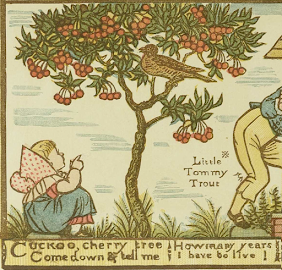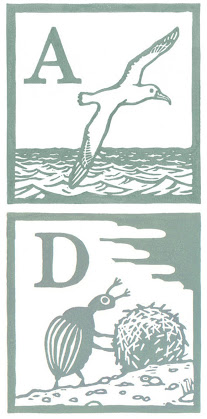It’s time for the 2023 April A to Z Blog Challenge! The A to Z Challenge involves bloggers from all around the world, who each share 26 blog posts throughout the month of April, working their way through the alphabet from A to Z. This will be my 8th A to Z, and yes, there are some things that I intend to do the same way I always do:
• Starting early so I can take a few extra days off during April
• Offering you lots of links to previous posts with additional bonus information
• Morals! Sure, morals have absolutely no intrinsic connection to this year’s theme, but you know what? My A to Z posts have included morals for the past 4 years, and I reckon by now it’s simply what I do. What can I say; I’m just a sententious kind of person.
However, despite continuing to observe my own customs, what will be unique for this year is, of course, a new and exciting theme. After several years of fantasy topics, it’s time to give block printing the spotlight, and this year I’m going meta and offering an alphabet of alphabets. Get ready for Relief Printed Alphabet Squared! In each post I’ll introduce you to some alphabets that are all illustrated with relief block prints. I’ll give you the illustration for the letter in question, as well as my favorite illustration from the entire set. And of course sometimes there might be more. (If you miss the fantasy, don’t worry. I can never resist letting a few strange and fantastical characters sneak in!)
As for today, of the seven letters in the title picture above, five will be introduced later, as will this A is for Apple. You’ll have to stay tuned and join me throughout April to find out where they all come from! The other letters featured today are part of alphabets that aren't going to get their own posts. In some cases that’s because I wasn’t able to find a complete (or even mostly complete) alphabet. In other cases it’s because I couldn’t figure out any way to assign their alphabet to a letter that wasn’t already full! (As usual in alphabets, some letters are oversubscribed, while others go begging for more.) Therefore I’ll tell you about those letters today.
The second B in the title picture, with a Boat, comes from a nineteenth century primer, and although we’ll see many primers in the coming weeks, there will be no more from this particular book. The second C in the title collection, shaped like a crocodile, is a modern linocut by Mark Long. I’d have loved to feature that alphabet, but I couldn’t find good pictures of most of its letters. However, there will be one more from his alphabet coming up as an icon for one of the letters, and another in the grand finale, so keep your eyes open for them! The yellow X comes from Cousin Honeycomb’s New Royal ABC from 1855. That little book has no pictures illustrating its letters, but just large, fancy colored capitals (of which one more will also appear shortly as a letter icon).
The A for Alligator is a 2 color linoleum block print by Kerry and Neil Stavely. I like the spiky A which looks appropriate to both the water plants and the alligator’s teeth and claws.
B is for a number of things in Karin Rytter’s Linocut ABC. Bear is the most obvious, but her detailed and accurate scene also includes Birch trees, Berries, and possibly some other things. I particularly like the bear cub climbing up the trunk of the letter. My other B is for Bridge and I find this a particularly charming little composition. It’s one of the earlier alphabets in this series, dating back to 1808. Like all the early ones, the color was hand-painted over plain black wood block printing.
This amazing C is for Crypt, Church, and dozens of other words in Italian, which is its native language. Many of them also work in English. Although I really enjoy the entire architectural alphabet by Antonio Basoli, I haven’t featured it elsewhere because it’s engraved and printed intaglio, not relief printed. (However, I couldn’t resist one other letter from another engraved architectural alphabet by another artist, so don’t forget to look for that among the letter icons to come.) The other C today is for Cock, and brings things back down to reality with The Farmer Boy’s Alphabet, printed with multiple blocks in multiple colors.
So, now you’ve had a taste of some of the alphabetical block printed delights in store. If you’re ready to get started early with this A to Z Challenge, come back for my very next post and find out what Alphabets A is for. But if you prefer to participate at the right and proper time, don’t worry. Each day in April I’ll include links to send you to the officially designated letter. Either way, I’ll see you soon!
The moral of this theme is of course that even alphabets should be alphabetized! Just remember the famous rhyme: A before B, especially before C… Or something like that, anyway.
So, when you see an illustrated alphabet, do you go through in order, or do you skip straight to your initials to see whether they’re good pictures? (My name starts with A, so I don’t even have to choose between those two approaches!)
[Pictures: X, hand-colored woodcut from Cousin Honeycomb’s New Royal ABC, 1855 (Image from Toronto Public Library);
Boat, wood block print by John Gilbert from The Prince of Wales’ Primer, 1847 (Image from Toronto Public Library);
Crocodile, linocut by Mark Long (Image from Typography Daily);
Alligator, linocut by Kerry and Neil Stavely (Image from Horse & Hare);
Bear, linocut by Karin Rytter (Image from Karin Rytter Studio);
Bridge, hand-colored wood block print from The Royal Alphabet, 1808 (Image from University of California);
Church, copper engraving by Antonio Basoli from Alfabeto Pittorico, 1839, (Image from Storia e Memoria di Bologna);
Cock, wood block print possibly by Harrison Weir from The Farmer Boy’s Alphabet, 1860 (Image from University of Florida).]





























